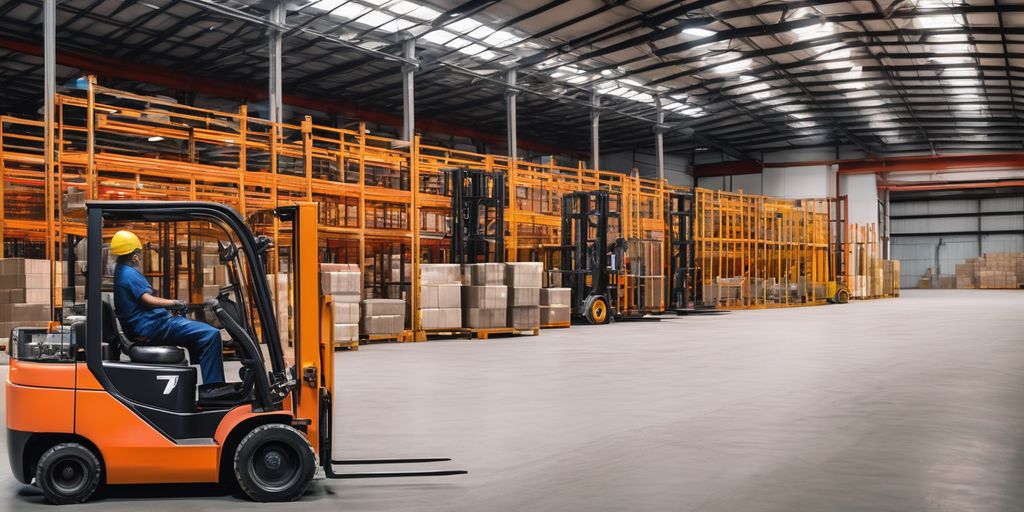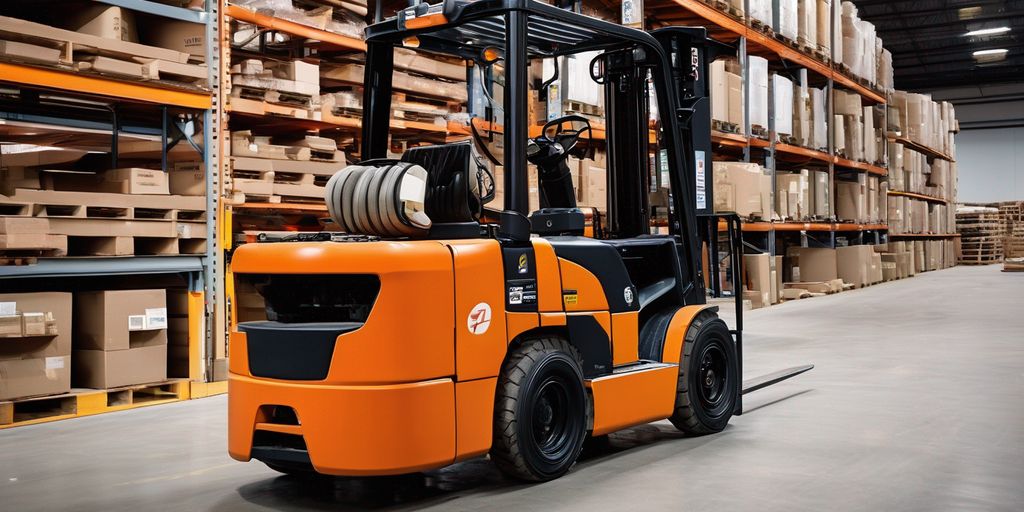Choosing the right forklift for your business is a critical decision that can significantly impact your operational efficiency and productivity. With various types of forklifts available, each designed for specific tasks and environments, it's essential to thoroughly evaluate your business needs and the features of each forklift type. This guide will help you navigate the key considerations to ensure you select the optimal forklift for your business.
Key Takeaways
- Understand the different types of forklifts and their specific applications to match your operational needs.
- Evaluate load capacity and lift height requirements to ensure the forklift can handle your typical loads safely and efficiently.
- Consider the fuel options and efficiency of forklifts to find the most cost-effective and environmentally friendly solution.
- Assess your work environment and terrain to choose a forklift that can operate effectively in your specific conditions.
- Prioritize safety features and ergonomic design to enhance operator comfort and reduce the risk of accidents.
Understanding Different Types of Forklifts
When it comes to how to choose the right forklift, it’s a good idea to familiarize yourself with the options available. Knowing the different types is crucial when choosing the best forklift for your needs. The different types of forklifts include:
Evaluating Load Capacity and Lift Height

When selecting a forklift, assessing the lifting capacity is crucial as it directly impacts both safety and operational efficiency. The capacity of a forklift to lift and transport loads should align with your business's regular needs. It's important to consider not just the maximum weight but also the height to which the load can be lifted.
Ensure the forklift you choose can handle the maximum weight your business operations require on a regular basis.
Considering Fuel Options and Efficiency
Choosing the right fuel option for your forklift is essential for maximizing efficiency and meeting your business needs. Each fuel type has its own set of advantages and limitations, making it crucial to evaluate them based on your specific operational requirements.
Electric Forklifts
Electric forklifts are powered by large, heavy lead-acid batteries, typically providing enough power for one standard eight-hour shift or about five to six hours of continuous use. The two biggest advantages of this system are that it produces zero emissions and is highly economical in terms of fuel. This makes electric forklifts an excellent choice for indoor operations where air quality is a concern.
Internal Combustion Forklifts
Internal combustion (IC) forklifts run on diesel, propane (LPG), or compressed natural gas (CNG). These forklifts are generally more powerful and can handle heavier loads compared to their electric counterparts. However, they produce emissions, making them less suitable for indoor use. IC forklifts are ideal for outdoor operations and environments where high power and endurance are required.
Alternative Fuel Forklifts
Alternative fuel options, such as hydrogen fuel cells, are emerging as viable choices for forklift operations. These options offer the benefits of quick refueling and reduced emissions. While still relatively new, they are gaining traction in industries focused on sustainability and efficiency.
Selecting the appropriate power type is a crucial decision that can significantly impact your operational efficiency and compliance with emissions regulations.
Assessing Work Environment and Terrain
When choosing a forklift, it's crucial to assess the primary environment where it will be used. Indoor and outdoor environments present different challenges and requirements for forklifts. The type of terrain your forklift will be operating on is closely tied to whether you’ll be using it indoors or outdoors. Indoor terrain will normally be a smooth cement surface that’s found in most warehouses and loading bays, and this surface is ideally suited to the small, solid wheels of an electric forklift.
Outdoor terrain, which can be asphalt, gravel, or even raw ground, is usually much less uniform than indoor surfaces. This will influence the wheel type and power supply your forklift needs.
Indoor vs. Outdoor Use
Indoor environments typically feature smooth, cement surfaces, making them ideal for electric forklifts with small, solid wheels. On the other hand, outdoor environments can vary significantly, from asphalt to gravel or raw ground. This variability requires forklifts with more rugged features and appropriate tire selection to ensure performance, safety, and efficiency.
Navigating Narrow Aisles
In many warehouses, space is at a premium, and forklifts must be able to navigate narrow aisles efficiently. Reach trucks and other specialized forklifts are designed to operate in these confined spaces, offering enhanced maneuverability and precision.
Handling Rough Terrain
For operations that require forklifts to handle rough terrain, such as construction sites or outdoor storage areas, it's essential to choose models designed for these conditions. Maneuverability is key when navigating rough terrain, so look for forklifts with responsive steering and agile handling. Additionally, pneumatic or solid tires are best suited for these environments to ensure stability and durability.
Prioritizing Safety Features and Ergonomics
When selecting a forklift, safety should be a top priority. Key features to consider include stability, visibility from the cab, and the presence of safety enclosures. Effective braking systems, warning systems, and speed control are essential to prevent accidents. Additionally, operator restraints and emergency stop systems provide critical safety measures in case of an emergency.
Ergonomic Design
High-quality, adjustable seating is important as forklift operators are sitting in their machines for hours at a time. Design and placement of controls are important as well. Investing in quality ergonomics will lessen the likelihood of injuries, such as back pain or carpal tunnel syndrome, which can be caused by repetitive tasks performed in uncomfortable seating and reaching conditions.
Operator Training and Certification
Ensuring that operators are properly trained and certified is crucial for maintaining a safe work environment. Regular training sessions and certification renewals help keep operators up-to-date with the latest safety protocols and operational techniques.
Prioritizing forklift operator safety and ergonomics not only enhances productivity but also reduces the risk of workplace injuries.
Analyzing Total Cost of Ownership
Understanding the [total cost of ownership](https://www.aaaforklifts.com/blogs/news/10-key-considerations-when-buying-a-forklift-for-your-business-1) is crucial when considering a forklift for your business. This includes not only the purchase price but also long-term costs such as maintenance, fuel, and potential downtime. Here are some key factors to consider:
It's important to calculate these expenses over the lifespan of the forklift to get a true sense of what the total cost of ownership will be. Using the total cost of ownership as a guiding principle can help avoid unforeseen financial strain.
Exploring Technological Advancements
Telematics systems are revolutionizing how businesses manage their forklift fleets. By providing real-time data on forklift usage, maintenance needs, and operator performance, these systems help optimize operations and reduce downtime. Key benefits include:
- Enhanced tracking of forklift location and usage
- Predictive maintenance alerts
- Improved operator performance monitoring
Automation and robotics are at the forefront of forklift technology. Automated Guided Vehicles (AGVs) and Autonomous Mobile Robots (AMRs) are increasingly being used to streamline warehouse operations. These technologies offer:
- Increased efficiency and productivity
- Reduced labor costs
- Enhanced safety by minimizing human error
Embracing automation can future-proof your operations and keep you competitive in a rapidly evolving market.
Advanced safety systems are crucial for modern forklift operations. Features such as collision avoidance, real-time monitoring, and operator assistance systems significantly enhance workplace safety. Consider the following advancements:
- Collision detection and avoidance systems
- Operator assistance and training modules
- Real-time monitoring and alerts for hazardous conditions
Conclusion
In conclusion, selecting the right forklift for your business is a multifaceted process that requires careful consideration of various factors. From assessing your specific operational needs and understanding the types of loads you handle, to evaluating the work environment and ensuring compliance with safety regulations, each aspect plays a crucial role in making an informed decision. By thoroughly analyzing these elements, you can choose a forklift that not only enhances productivity and efficiency but also contributes to the overall safety and profitability of your operations. Armed with the insights provided in this guide, you are now better equipped to navigate the complexities of forklift selection and make a choice that best aligns with your business needs.
Frequently Asked Questions
What are the different types of forklifts?
The main types of forklifts include Counterbalance Forklifts, Reach Trucks, and Pallet Jacks. Each type serves different operational needs and environments.
How do I determine the load capacity needed for my forklift?
Load capacity is determined by the heaviest load you need to lift. It's important to consider the maximum weight and ensure the forklift can handle it safely.
What are the benefits of electric forklifts?
Electric forklifts are known for their efficiency, lower operating costs, and zero emissions, making them ideal for indoor use and environmentally conscious operations.
Is operator training and certification necessary?
Yes, operator training and certification are crucial for safety and compliance with regulations. Proper training helps prevent accidents and ensures efficient operation.
What factors should I consider for indoor vs. outdoor forklift use?
For indoor use, electric forklifts are often preferred due to their zero emissions and quiet operation. For outdoor use, consider forklifts that can handle rough terrain and varying weather conditions.
How does total cost of ownership affect my forklift choice?
Total cost of ownership includes the initial purchase price, maintenance and repair costs, and potential resale value. Evaluating these factors helps in making a cost-effective decision.




Leave a comment
This site is protected by hCaptcha and the hCaptcha Privacy Policy and Terms of Service apply.